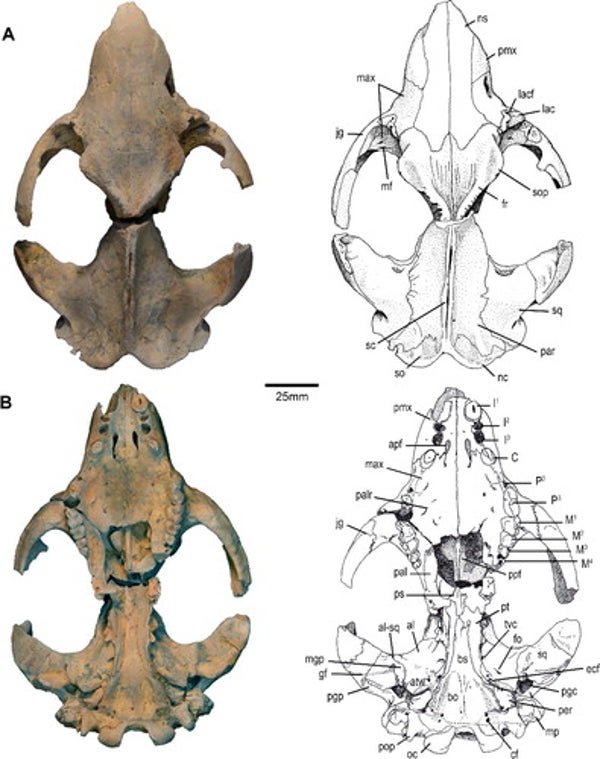This article was published in Scientific American’s former blog network and reflects the views of the author, not necessarily those of Scientific American
Wakaleo schouteni sounds like one of those animals that should be a myth. In fact, it resembles the legendary Australian drop bear more than just a little. This 50-pound marsupial would have looked something like a lanky version of a koala with meat-cleaver teeth, just as adept at climbing trees but preferring a diet of flesh to eucalyptus. Fantastic, perhaps, but the bones don't lie.
Paleontologist Anna Gillespie and colleagues named this new species of "marsupial lion" from a nearly-complete skull and additional postcranial bones found in the 26-19 million year old deposits of Australia's Riversleigh World Heritage Area. It's not the only beast of its kind ever known. Its larger, later relative Thylacoleo carnifex is the family's standard bearer. But the announcement of Wakaleo schouteni is a wonderful reminder that Australia's ancient carnivores evolved in their own unique and unexpected ways, carving out their own way to be leopard-like hunters.
And this isn't just about naming something new. Every new fossil species added to the list of known prehistoric life helps throw others into context. In this case, Gillespie and coauthors explain, the analysis of Wakaleo schouteni revealed that another marsupial lion named half a century ago - Priscileo pitikantensis - should actually be a species of Wakaleo, too. This other Wakaleo species is just about as old, going back to the Late Oligocene, and points to an even earlier origin for the group. This gives paleontologists all the more reason to dig in deeper, scratching away at the evolutionary origin of these marsupial copycats.
On supporting science journalism
If you're enjoying this article, consider supporting our award-winning journalism by subscribing. By purchasing a subscription you are helping to ensure the future of impactful stories about the discoveries and ideas shaping our world today.

The skull of Wakaleo schouteni. Credit: Gillespie et al 2017
Name: Wakaleo schouteni
Meaning: The established genus Wakaleo means "small lion", and schouteni honors paleoartist Peter Schouten.
Age: Oligocene-Miocene, between 26 and 19 million years ago.
Where in the world?: Riversleigh World Heritage Area, Australia.
What sort of organism?: A marsupial mammal belonging to a group called the Thylacoleonidae.
How much of the organism’s is known?: A nearly-complete skull and additional postcranial bones.
References:
Gillespie, A., Archer, M., Hand, S. 2017. A new Oligo-Miocene marsupial lion from Australia and revision of the family Thylacoleonidae. Journal of Systematic Palaeontology. doi: 10.1080/14772019.2017.1391885
Previous Paleo Profiles:
The Light-Footed Lizard The Maoming Cat Knight’s Egyptian Bat The La Luna Snake The Rio do Rasto Tooth Bob Weir's Otter Egypt's Canine Beast The Vastan Mine Tapir Pangu's Wing The Dawn Megamouth The Genga Lizard The Micro Lion The Mystery Titanosaur The Echo Hunter The Lo Hueco Titan The Three-Branched Cicada The Monster of Minden The Pig-Footed Bandicoot Hayden's Rattlesnake Demon The Evasive Ostrich Seer The Paradoxical Mega Shark The Tiny Beardogs The Armored Fish King North America's Pangolin The Invisible-Tusked Elephant The Mud Dragon The Spike-Toothed Salmon The Dream Coast Crocodile Buriol's Robber Ozimek's Flyer The Northern Naustoceratopsian The High Arctic Flyer The Tomatillo From the End of the World The Short-Faced Hyena The Mighty Traveler from Egg Mountain Keilhau's Ichthyosaur Mexico's Ancient Horned Face Mauricio Fernández's Plesiosaur New Zealand's Giant Dawn Penguin The Orange Sea Lion Mongolia's Ginkgo Cousin The Geni River Frog Isabel Berry's Dinosaur The Whale Caiman The Moab Lizard Yang Zhongjian's Lizard The Little Anubis The Shuangbai Lizard The Wyvern Dinosaur The "Need Helmet" Dinosaur The Jianianhua Dragon The Liaoning Hunter The Dalian Lizard Crompton's Aleodon Jenkins' Amphibian Serpent From the Chinle The Large Ancestor Lizard The Crown Tooth Currie's Alberta Hunter The Elephant Bird Mimic The Crested Thief The Hiding Hunter The Horned Lizard The Silk Bird The Sieve-Toothed Plesiosaur The Defenseless Snout Burian's Lizard The Small Whaitsiid The Beautiful Bird The Fierce Cat The Older One From Melksham The King of the Miocene Iberian Giraffes Miera's Lizard The Traveling Sloth The Sand Whale